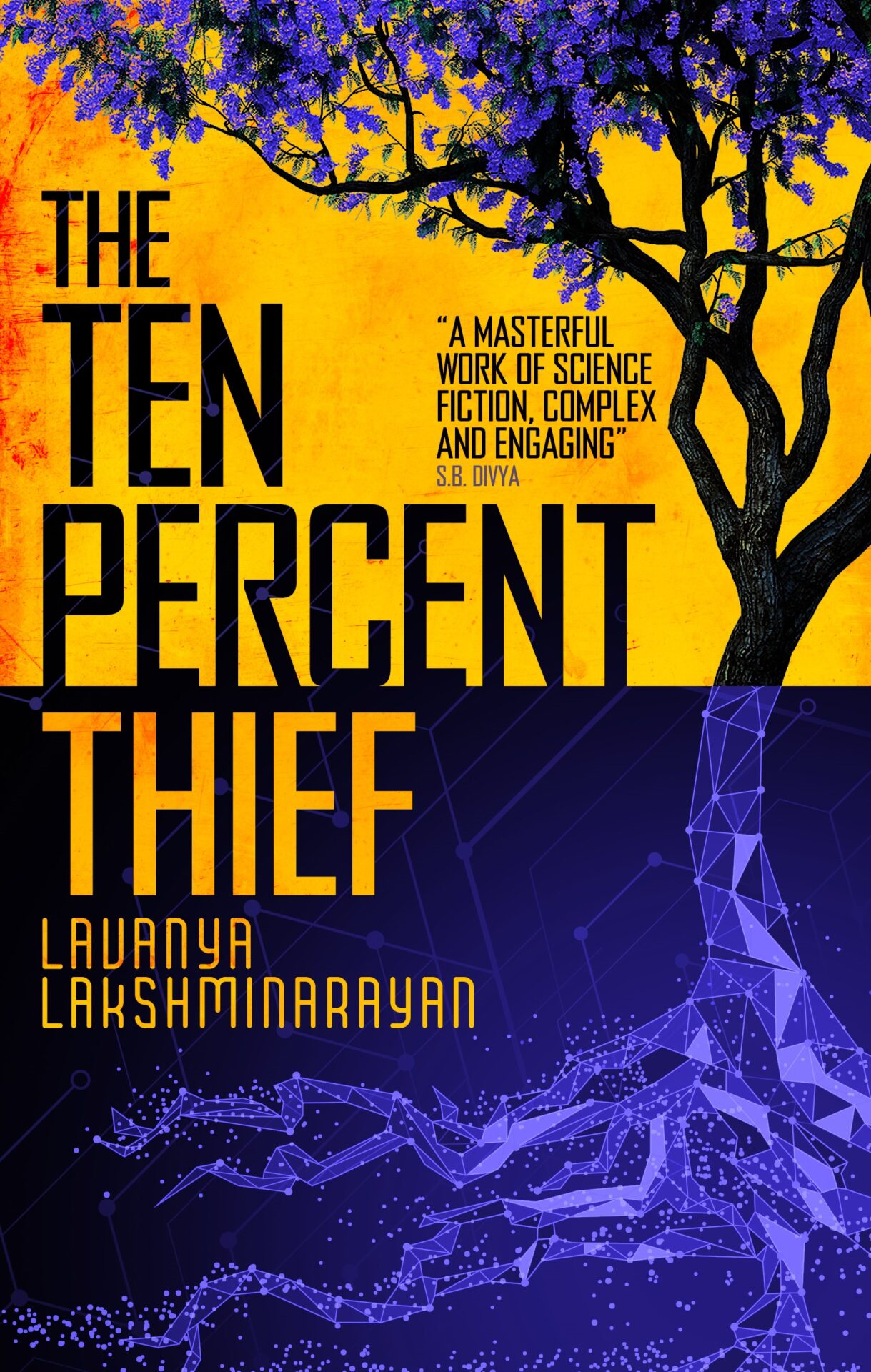
Lavanya Lakshminarayan is joining us today to talk about her novel, The Ten Percent Thief. Here’s the publisher’s description:
Welcome to Apex City, formerly Bangalore, one of the last bastions of civilization in a world ravaged by climate change. Governed by an insidious corporation, everything is decided by the mathematically precise Bell Curve.
With optimal productivity, and the right image and values, you can ascend to the glittering heights of the top twenty percent of society–the Virtual elite–and have the world at your feet. The latest holotech and climate control, real-world vacations, olfactory simulations, private garden spaces… all this could be yours, so long as you get to the top and stay there. Slide down the Curve and you risk finding yourself in the bottom ten percent, to be deported to the dust city of the Analogs, with no access to running water, electricity, or your humanity.
The system has no flaws. The city has never been more at peace. Its citizens have never been happier–or more productive. Until the elusive ‘Ten Percent Thief’ steals a single jacaranda seed from the Virtual city, and plants a revolution in the barren soil of the Analog world.
Apex City is poised to shatter.
The Ten Percent Thief was previously published in South Asia only as Analog/ Virtual. The South Asian edition was shortlisted for a Locus Award, longlisted for a BSFA Award, and won multiple literary awards in India. The Washington Post described it as “a virtuoso mosaic novel”, and it was reviewed by Ian Mond in Locus, who described it as “exciting, imaginative, and provocative.”
What’s Lavanya’s favorite bit?

Lavanya Lakshminarayan
I wrote The Ten Percent Thief to examine social hierarchies and the fallacy of meritocracy in the Indian context. It features an extreme version of the future, where society is primarily divided by access to technology. But a strong social hierarchy can’t be enforced through the denial of tangible privileges alone. If you examine human history, as I did, all the way from the caste system to colonization, the oppressor has always found ways to remind the oppressed to know their place by building and maintaining systems of subjugation that incorporate aesthetic and cultural values. The intent is to reiterate the innate inferiority and lack of worth of the oppressed—in the eyes of the oppressor—by devaluing their identities.
If the dystopian surveillance state in my novel had to succeed, I needed to establish a similar hierarchy of identity influences. So, I zeroed in on what I believe is one of the most powerful ways to reinforce a social pecking order: pop culture.
Hyper Reality simulations and a whole spectrum of holoray television programming provide entertainment to the Virtual elite. Stories round the bonfire are about all the Analogs can access in their dusty wasteland. Stark disparity, sends the message home, but I wanted to do more.
I’m a painfully shy pianist and an audiophile, with a massive music library and expansive taste. I never know if I’ll wake up feeling like K-pop or Bach, showtunes or progressive metal. You’ll almost never find me without my headphones on, or humming a tune, or tinkering with the piano. Music brings depth to my life. I knew right away that I had to include it in this book.
I loved designing new, futuristic genres of music to represent the ‘high culture’ of the Virtual elite and the ‘low culture’ of the Analog outcasts. Each genre comes with its own sub-genres, complete with tonal qualities, instruments, forms of representation and production, and dedicated listeners, all of whom are influenced and shaped by what they listen to. I was inspired by music through the ages, and spent hours dream-producing the music in my world.
In Apex City, a fictional genre I call neoAcousta is the music of the elite. Played exclusively on acoustic instruments—a prized rarity in a heavily digitized world—neoAcousta is intended to “celebrate the purity of sound”. I took my inspiration from microtonal music, and so this fictional genre features a host of alternate tunings for traditional instruments like the piano and the ‘acou-guitar’. Real-world musicians across eras and genres, from Ivan Wyschengradsky to Radiohead, sparked the thought behind it.
This genre is a focal point in the story of John Alvares, who’s on a company-mandated program to finetune his taste in pop culture, and elevate it from his more inferior inclinations. He can only succeed in the world of the Virtual elite with the right cultural opinions, and so he’s exposed to a fictional orchestral suite titled ‘La Ménagerie’—I imagine it would sound like a microtonal version of Erik Satie’s ‘Gnossiennes’ blended with Philip Glass’s ‘Heroes Symphony’.
Meanwhile, Nina Anand is an Analog adoptee in the Virtual world, and her dream is to be a piano virtuoso. Her hero is a blind woman pianist and composer who shares her first name—and happens to be my tribute to Nannerl Mozart, Clara Schumann, and all the other non-male composers who have historically been erased and discredited. Apart from facing systemic discrimination, Nina’s raw talent and natural ability are frequently questioned because of her origins as an Analog—after all, how could anyone from her background have an appreciation for refined culture?
The Virtual elite’s scorn of Analog culture is apparent in their opinions on the most popular music in the Analog world—anatronica. Entirely digitally synthesized, system-approved anatronica is produced in a sanitized form by Virtual studios to keep the Analogs in their place. But real anatronica is underground; produced by Analog rebels using stolen electricity, sparking revolution. Arun Nair decrypts the password to an insurgent movement from an anatronica song, and goes on a quest to find the speakeasy where the rebellion meets. Anatronica underscores the Analog movement, existing in my mind as a blend of Janelle Monáe’s futuristic sound, including her political storytelling, Trent Reznor’s dissonant electronic tracks, and Rage Against the Machine’s aggression and, well… rage against the machine.
Occupying middle ground is Hype—upbeat music with lyrics that convey system-sanctioned dreams about driving fast cars and making it to the top of society. This is a genre of music that’s the lovechild of bubblegum and space pop, a sound of hope, early Miley Cyrus meets Air. Hype is acceptable, if not elite, and functions as the go-to for all the people occupying the middle seventy percent of society, turning the cogs in the wheels that make the machine run. Easy listening, the perfect internet radio station.
Each of these genres came to me with a unique sound, and all of them perform a strong role in reasserting the cultural values that determine hierarchy in The Ten Percent Thief. It was a dizzying experience to dream them and try to make them come alive on the page. Maybe someday, I’ll get to produce an original soundtrack. Until then, I hope you’ll enjoy imagining the sound of the future—and bringing your own influences to it—as much as I did.
LINKS:
The Ten Percent Thief universal book link
BIO:
I’m Lavanya Lakshminarayan, and I’m a writer and game designer from Bangalore, India. My short fiction has appeared in The Best of World SF: Vol 2 and Someone In Time: Tales of Time-Crossed Romance, among other magazines and anthologies. As a game designer, I’ve built worlds for the FarmVille and Mafia Wars franchises, tinkered with augmented reality, and custom-built battle robots in my living room. The Ten Percent Thief draws upon my experiences as a woman working in the gaming industry, and at tech start-ups, in India and around the world.
